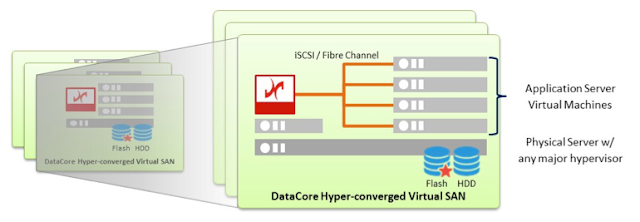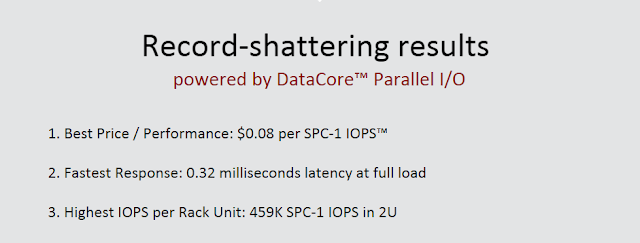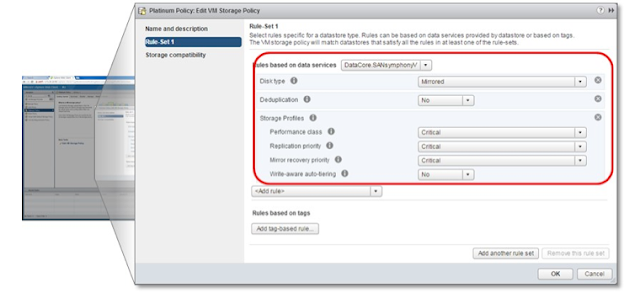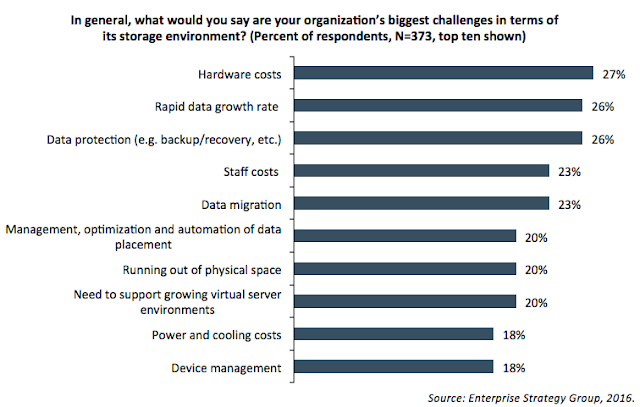The New Report Spotlights the “Top 10 Biggest
Storage Challenges” and Details Test Results on DataCore’s Application-Adaptive
Data Infrastructure, Self Provisioning VVols, Hyper-converged Simplicity,
Parallel I/O Performance, Automated Storage Tiering, Continuous Data Protection
and More
“It would benefit any organization considering or implementing an IT virtualization
project to take a long look at DataCore Software.” - Tony Palmer, senior lab analyst, ESG Lab
A new hands-on evaluation and testing report performed by
Enterprise Strategy Group (ESG) Lab covering DataCore SANsymphony and Hyper-converged
Virtual SAN software has just been released.
“DataCore’s SANsymphony and Hyper-converged Virtual SAN solutions
proved to be robust, flexible, and responsive. The company now finds itself
with incredibly relevant capabilities that truly matter to users. We found the
software easy to implement and manage, virtualizing any storage infrastructure
with enterprise-class features and functionality while enhancing performance,” said
Tony Palmer, senior lab analyst, ESG Lab. “ESG Lab was especially impressed with
DataCore’s parallel I/O technology and its ability to deliver enterprise-class
performance running on low-cost commodity hardware.”
The report also highlights ESG’s survey results on the “Top
10 Biggest Storage Challenges.” The lab testing, performed independently, was
done to assess the value of DataCore’s infrastructure-wide storage
virtualization and hyper-converged solutions for the data center, and the tests
were designed to validate the flexibility and ease of management in a
heterogeneous, highly virtualized environment. ESG also examined DataCore
Software’s performance, efficiency, and availability in fully virtualized and
hyper-converged configurations.
ESG Lab Validation Highlights:
- Enables
Enterprise-class Hyper-converged Data Infrastructure
ESG Lab found that virtualizing infrastructure with DataCore
Hyper-converged Virtual SAN was intuitive and straightforward. During the evaluation,
a pair of servers running a hypervisor and DataCore Hyper-converged Virtual SAN
provided a highly available platform to run multiple simulated applications and
enterprise workloads. When a server failure was simulated with a hard power
off, virtual machines and storage failed over to the surviving node immediately
and automatically. A new server was installed and added to the Failover
Cluster–seamlessly and painlessly–while applications remained online and
continously available.
DataCore Hyper-converged Virtual
SAN
ESG also tested,
reviewed and reported on DataCore’s ability to go beyond traditional
hyper-converged performance limits and run demanding enterprise-class
application and storage workloads. DataCore’s hyper-converged solutions provide
a range of performance and application adaptive acceleration capabilities, the
most significant being its parallel I/O software.
“DataCore has been hyper-converged since before there was such a term
in the industry, so it’s no surprise that its hyper-converged offering is
robust, highly available, and offers very impressive price-performance with the
full complement of enterprise-class functionality that DataCore has been honing
for nearly two decades,” added Palmer.
- Drives
Fastest Response Times and Industry-best Price Performance
DataCore’s parallel I/O software technology is designed to
adaptively harness available multi-core processors to optimize and schedule I/O
processing across many different cores simultaneously. It actively senses I/O
load being generated by multiple VMs concurrently and dynamically assigns CPU
cores as needed to process the I/O load. This enables DataCore to take full
advantage of modern multi-core server technologies to eliminate I/O bottlenecks,
speed up application performance, and drive greater workload and virtual
machine density per server.
ESG Lab reviewed DataCore’s recently-published Storage
Performance Council SPC-1 benchmark results. “DataCore has published an
excellent result of 459,290 SPC-1 IOPS at 100% load with an average response
time of only 0.32 milliseconds in a hyper-converged configuration1,”
continued Palmer. “The 0.32 millisecond result at 100% load is the fastest
response time ever reported by SPC-1, and showcases the power of parallel I/O
software to significantly reduce the time it takes for applications to access,
store, and update their data.”
DataCore set a new SPC-1 price-performance record. At full load, SANsymphony was
responding at nearly two orders of magnitude below the 30 milliseconds response
time threshold set by the Storage Performance Council and at 0.32 milliseconds,
it is three times faster than the one milliseconds threshold considered to be
the standard for all-flash systems.
ESG stated that the DataCore SPC-1 result proves its
suitability for response time sensitive applications (e.g., Virtualization and
Database workloads, OLTP, ERP, etc.) and demonstrates the headroom available to
scale up and scale out to much larger configurations and capacities.
- Simplifies
VMware vSphere Storage Management: Self-Provisioning with VVols
Administrators crave the simplicity, power and fine-grain
control promised by vSphere Virtual Volumes (VVols); however, most current
storage arrays and systems do not support VVols. With DataCore enabled,
virtually any storage becomes VVol capable allowing VMware vSphere
administrators to self-provision virtual volumes from virtual storage pools --
and instantly specify the capacity and class of service needed for their
applications without having to know anything about the storage or underlying
hardware.
ESG Lab tested DataCore self-provisioning
VVols. In the testing scenario, ESG set up Platinum, Gold, Silver, and Bronze
policies to define different levels of service. DataCore made provisioning
storage a seamless, integrated part of VM creation, empowering administrators
to provision storage for virtual machines using predefined storage policies
that were able to define performance, availability, and locality of data
without ever having to touch the back-end storage.
DataCore automatically took care of the entire
behind-the-scenes configuration, which is the responsibility of specialized
storage administrators in traditional storage environments. ESG Lab reported
that it was impressed with the speed, simplicity, and completeness of the
DataCore integration. Virtual machines based on these predefined profiles were
created in minutes using native VMware tools. ESG noted that this capability is
particularly of value as much of the existing storage in data centers can never
be retrofitted to support VVols, so the fact that SANsymphony extends VVols
self-provisioning to existing storage investments and any new devices not yet
able to support VVols is a powerful capability.
- Automates
Infrastructure-wide Storage Tiering to Maximize Cost-Effective Performance
ESG Lab also validated the business value of DataCore’s
automated storage tiering. All performance testing was completed using test
tools to simulate a typical OLTP workload. ESG first measured the performance
on a non-tiered storage pool using a SAS disk. Next, an SSD was added to the
storage pool. The software immediately started the rebalancing process of
tiering, moving hot, or frequently accessed, data blocks from the SAS disk to
the higher performance flash disk.
After completing the rebalancing process, the DataCore
solution dedicated all resources to performing storage operations for the
application. The effect of storage tiering was immediately visible, the
DataCore software reported a total of 1,392 IOPS—a 700% improvement over the
non-tiered storage pool.
- Supports
Continuous Availability, Metro-wide Clustering, Remote Disaster Recovery,
Advanced Data Protection and Automated Failover and Self-healing
Functionality
ESG Lab further validated that DataCore SANsymphony and
Hyper-converged Virtual SAN provide an array of advanced data protection
capabilities that can cost-effectively satisfy the most stringent business
continuity and disaster recovery requirements. Synchronous mirroring across
metropolitan areas, automated failover and self-healing, full and incremental
snapshots, roll-back in time
Continuous Data Protection (CDP), and asynchronous
remote replication to distant disaster recovery sites can all be used without
being dependent on any specific model or brand of storage device. For example,
customers can take advantage of a hyper-converged system at a remote site and
establish it as a contingency site for larger data centers.
ESG also noted that DataCore’s CDP capability was easy to
configure and use, enabling rollback to a specific point in time without having
to create multiple snapshots. An ideal solution for recovering the state of
applications and configurations prior to bad events when snapshots were not
invoked or to recreate ‘any-point in time’ restores.
View the ESG Lab Report and the Top 10 Biggest Storage
Challenges
In addition to the lab report on DataCore, ESG recently
conducted a survey of 373 IT professionals and respondents who were asked to
identify what they would consider to be their biggest challenges with respect
to their storage environment. As one might expect from a captive audience of
server virtualization users, there was significant focus on both data growth
and data protection (each cited by 26% of respondents), as well as staff costs
and data migration (coming in at 23% each). Perhaps of greatest interest and
significance, however, is that hardware costs (27%) was the most-cited storage
challenge.
Bottom-line, in addition to the
added flexibility to deal with growth and change, overcoming total cost of
ownership including the rising people and hardware costs are now the primary
business motivators driving the increased momentum to deploy software-defined
storage solutions such as those from DataCore.
View the complete ESG Lab Report and Survey
Information here.




